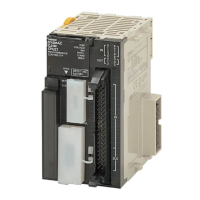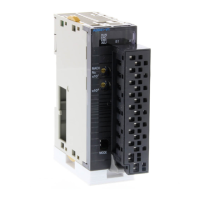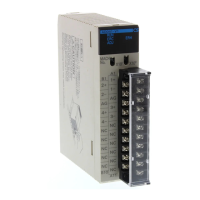87
As shown in the following diagram, more than one INTERLOCK instruction
can be used within one instruction block; each is effective through the next
INTERLOCK CLEAR instruction.
Instruction 1
00000
Instruction 2
00001
ILC(03)
IL(02)
00004
Instruction 3
Instruction 4
00006
00005
00003
00002
IL(02)
Address Instruction Operands
00000 LD 00000
00001 IL(02) ---
00002 LD 00001
00003 Instruction 1
00004 LD 00002
00005 IL(02) ---
00006 LD 00003
00007 AND NOT 00004
00008 Instruction 2
00009 LD 00005
00010 Instruction 3
00011 LD 00006
00012 Instruction 4
00013 ILC(03) ---
If IR 00000 in the above diagram is OFF (i.e., if the execution condition for
the first INTERLOCK instruction is OFF), instructions 1 through 4 would be
executed with OFF execution conditions and execution would move to the
instruction following the INTERLOCK CLEAR instruction. If IR 00000 is ON,
the status of IR 00001 would be loaded as the execution condition for instruc-
tion 1 and then the status of IR 00002 would be loaded to form the execution
condition for the second INTERLOCK instruction. If IR 00002 is OFF, instruc-
tions 2 through 4 will be executed with OFF execution conditions. If IR 00002
is ON, IR 00003, IR 00005, and IR 00006 will determine the first execution
condition in new instruction lines.
4-6-8 Jumps
A specific section of a program can be skipped according to a designated
execution condition. Although this is similar to what happens when the exe-
cution condition for an INTERLOCK instruction is OFF, with jumps, the oper-
ands for all instructions maintain status. Jumps can therefore be used to con-
trol devices that require a sustained output, e.g., pneumatics and hydraulics,
whereas interlocks can be used to control devices that do not required a sus-
tained output, e.g., electronic instruments.
Jumps are created using the JUMP (JMP(04)) and JUMP END (JME(05))
instructions. If the execution condition for a JUMP instruction is ON, the pro-
gram is executed normally as if the jump did not exist. If the execution condi-
tion for the JUMP instruction is OFF, program execution moves immediately
to a JUMP END instruction without changing the status of anything between
the JUMP and JUMP END instruction.
All JUMP and JUMP END instructions are assigned jump numbers ranging
between 00 and 99. There are two types of jumps. The jump number used
determines the type of jump.
A jump can be defined using jump numbers 01 through 99 only once, i.e.,
each of these numbers can be used once in a JUMP instruction and once in
a JUMP END instruction. When a JUMP instruction assigned one of these
numbers is executed, execution moves immediately to the JUMP END in-
struction that has the same number as if all of the instruction between them
Inputting, Modifying, and Checking the Program Section 4-6

